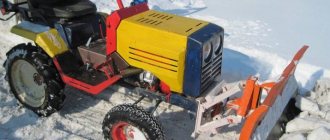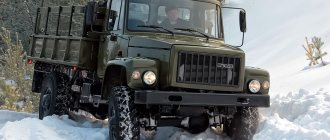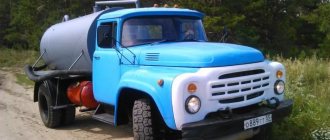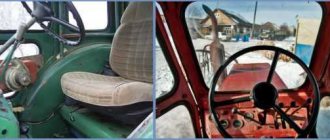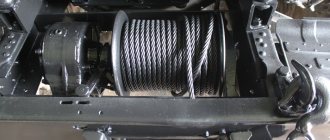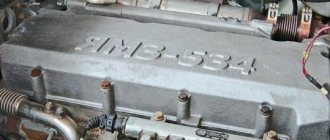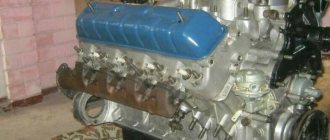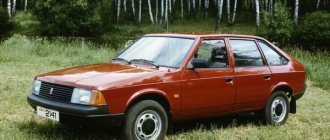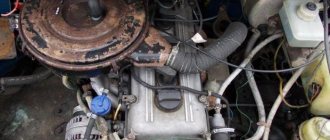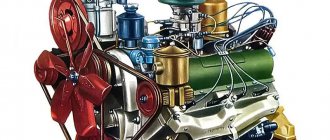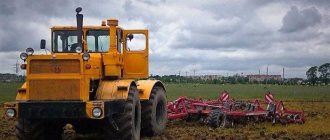History of creation
By the middle of the last century, the product line of the Zavolzhsky Motor Plant was morally and technically outdated. The design of the bottom engines, although notable for its reliability, required replacement with a more modernized type. Therefore, during this period, a V-shaped engine with eight cylinders ZMZ-13 was born. It was made entirely of aluminum, which helped reduce the weight of the already heavy engine. With a volume of 5.5 liters, this unit produced 195 horsepower. Such a high power rating was only possible with the transition to a top-mounted design.
After some time the motor was improved. The fuel compression ratio has increased, which led to the transition to 92-octane gasoline. The cooling and lubrication system has been improved. In general, the technical characteristics of the ZMZ-13 have become much better. The success of this unit was high, so it was decided to install it on military equipment.
Passenger engines marked V8 from ZMZ
The ZMZ V8 passenger engine was installed only on Chaika cars marked GAZ-13 and GAZ 14. Increased technical characteristics allowed the vehicle to accelerate quickly.
The only drawbacks of these power units are increased fuel consumption.
Technical characteristics of ZMZ 13:
| Name | Characteristic |
| Plant manufacturer | GAS |
| Engine make | ZMZ |
| Model | 13 |
| Volume | 5.5 liters (5526 cm3) |
| Number of cylinders | 8 |
| Configuration | V |
| Number of valves | 16 |
| Cooling | Liquid |
| Power | 195 hp |
| Block and head, version | Aluminium, wet cast iron sleeves |
| Cylinder operating order | 1-5-4-2-6-3-7-8 |
| Fuel | AI-93 |
| Standard piston diameter | 100 mm |
| Piston stroke | 88 mm |
| Nutrition | Carburetor K-113, K-114 |
Technical characteristics of ZMZ 13D:
| Name | Characteristic |
| Plant manufacturer | GAS |
| Engine make | ZMZ |
| Model | 13D |
| Volume | 5.5 liters (5526 cm3) |
| Number of cylinders | 8 |
| Configuration | V |
| Number of valves | 16 |
| Cooling | Liquid |
| Power | 215 hp |
| Block and head, version | Aluminium, wet cast iron sleeves |
| Cylinder operating order | 1-5-4-2-6-3-7-8 |
| Fuel | 100 octane |
| Standard piston diameter | 100 mm |
| Piston stroke | 88 mm |
| Nutrition | Carburetor K-113, K-114 |
Technical characteristics of ZMZ 14:
| Name | Characteristic |
| Plant manufacturer | GAS |
| Engine make | ZMZ |
| Model | 13D |
| Volume | 5.5 liters (5526 cm3) |
| Number of cylinders | 8 |
| Configuration | V |
| Number of valves | 16 |
| Cooling | Liquid |
| Power | 220 hp |
| Block and head, version | Aluminum |
| Cylinder operating order | 1-5-4-2-6-3-7-8 |
| Fuel | AI-95 |
| Standard piston diameter | 100 mm |
| Piston stroke | 88 mm |
| Nutrition | Carburetor K-113, K-114 |
The only difference between the engines is the fuel used and the amount of horsepower.
ZMZ-41 - technical characteristics
ZMZ-13 underwent another, now fundamental, change, so it was assigned a different index. The new engine became known as ZMZ-41. The main changes concerned the transition to cheaper A-76 fuel. Also, to reduce wear on parts, a vacuum limiter was added to the maximum number of revolutions. The compression ratio of gasoline in the cylinder now reached 6.7. All this contributed to a decrease in overall power. But be that as it may, the characteristics of the ZMZ-41 remained at a good level. Like the prototype, this engine has eight in-line cylinders located at an angle of 90 degrees, the volume of which is 5.5 liters. The rated power reaches 140 “horses”. The maximum rpm is 2500. This engine is equipped with a carburetor power system, namely the K-126 model, which boasts an accelerator pump and a cold start system. The device is also equipped with a three-speed gearbox.
Performance characteristics of BRDM-2
Crew, people: 4 Troops, people: 10 Years of production: from 1963 to 1990 Number of production, pieces: more than 9400
Weight BRDM-2
— 7.0 tons
Dimensions of BRDM-2
— Case length, mm: 5750 — Case width, mm: 2350 — Height, mm: 2395 — Base, mm: 3100 — Track, mm: 1840 front; 1790 rear - Ground clearance, mm: 330
BRDM-2 armor
— Armor type: rolled steel — Hull forehead (top), mm/deg.: 5 — Hull forehead (bottom), mm/deg.: 14 — Hull side, mm/deg.: 7 — Hull rear, mm/deg. : 7 — Bottom, mm: 2..3 — Hull roof, mm: 7 — Turret front, mm/deg.: 10 — Tower side, mm/deg.: 7 — Tower rear, mm/deg.: 7 — Roof towers, mm: 7
Armament of BRDM-2
— Firing range, km: 1..2 (KPVT); 1.5 (PKT) - Sights: PP-61AM - Machine guns: 1 x 14.5 mm KPVT; 1 x 7.62 mm PCT
BRDM-2 engine
— Engine type: GAZ-41 — Engine power, l. p.: 140
Speed BRDM-2
— Speed on the highway, km/h: 95..100 — Speed on rough terrain, km/h: 8..10 afloat — Cruising range on the highway, km: up to 750 — Specific power, l. s./t: 20.0
— Wheel formula: 4 × 4 (8 × 8) — Suspension type: semi-elliptical springs — Specific ground pressure, kg/cm²: 0.5..2.7 — Climbability, degrees: 30 — Climbable wall, m : 0.4 - Overcoming ditch, m: 1.22 - Overcoming ford, m: floating.
Pros and cons of ZMZ-41
A distinctive feature of the engines of the Zavolzhsky plant is their good maintainability. Simple repairs can be done “on site” with a minimum number of tools. Hence the availability of spare parts. They are cheap, and you can buy them at any specialty store. One of the main disadvantages of the ZMZ-41 can be considered its non-environmental friendliness and uneconomical nature. Namely, high fuel consumption, especially when traveling through bad areas. But even this minus can be solved on newer models by replacing the fuel supply system with an injection one. It can be found in models ZMZ-5245.
The ZMZ engine is one of the most popular domestic mechanical engineering products, used in many old and new types of automotive vehicles running on both diesel and gasoline.
The enterprise of the Zavolzhsky Motor Plant began to function in the first half of the 20th century, but at the end of the 1950s it became clear that the engines produced by the plant did not meet the modern requirements of wheeled and tracked vehicles.
Therefore, the company management decided to develop a new engine project for the automotive industry. The new engine of JSC ZMZ, which appeared in 1959, was a real breakthrough in mechanical engineering, since for the first time in the world it used V-shaped cylinder technology.
Motors of a similar structure in the West began to be widely used only 10 years later. This engine at that time had solid characteristics, such as 195 horsepower and a 3-speed automatic transmission, as well as the ability to use both diesel and gasoline fuel.
Therefore, Zavolzhsky Motor Plant can be considered the founder of modern ZMZ v8 engines, a review of new models of which is given below.
Design
The BRDM-2 has a layout with the control compartment located in the front, the fighting compartment in the middle, and the engine compartment in the rear of the vehicle. The crew of the BRDM consists of four people: the commander and driver, located in the control compartment on the right and left, respectively, the gunner, located in the turret, and the observer, occupying a place on the left or right side in the fighting compartment.
Armored hull and turret
Department of Management
The control compartment is located in the bow of the hull. The control compartment houses the machine controls, as well as the following equipment:
— Seats for commander and driver; — Instrumentation; — Radio station; — Observation devices.
The seats have a position adjustment system. In the niche of the right front wheel there is a bracket for the DP-3B radiometer. The remote unit of the device is fixed in the housing on the front bottom sheet.
In the event of a roadside landmine being detonated at least a short distance from the BRDM, unlike the American HUMVI, it did not receive any particular damage, unless, of course, half a ton of explosives were buried in the ground - well, then the tank would “fly”... not what a light armored vehicle. The truth is that when it comes to comfort... yes, the Humvee and the BRDM-2 cannot be compared. But it’s better to be hot and uncomfortable than cozy and then cold, but for good.
Combat compartment
The fighting compartment is located in the middle part of the vehicle. In order to access the power plant from inside the vehicle, there is a partition in the rear part of the fighting compartment in which special hatches are installed.
The fighting compartment has two seats for the vehicle's crew. A shoulder strap is installed on the roof, on which the vehicle's turret is located. The turret has a hanging seat to accommodate the shooter. In the center of the floor there is a sealed casing, under which the transfer case is located. In addition, there is a special niche in the floor for placing tools. The niche is closed with a hinged lid.
BRDM-2 overcomes a water obstacle
Power plant department
The power unit compartment is located at the rear of the housing. The power plant compartment houses:
— Drive for manual engine start; - Engine; — Fuel tank for starting heater; — Generating unit; — Filter-ventilation unit; - Transmission; — Air cylinders; — Water and oil radiators; - Accumulator battery; — Water and oil heat exchangers; — Cardan drive of the water-jet propulsion; — Compressor; — Evacuation valve; — Starting heater; — Electric water pump.
The water jet propulsion unit is installed in the rear of the vehicle. Water is taken from under the bottom. The propellers are equipped with propellers with a diameter of 500 mm. The tractive force at 900..1100 rpm of the propeller is 700 kgf. The propulsion unit is driven by a special power take-off mounted on the left side of the gearbox.
Armament
The BRDM-2 is armed with a twin mount of a 14.5 mm KPVT machine gun and a 7.62 mm PKT. The installation is placed on trunnions in the front part of the turret, its guidance in the vertical plane, within the range of −5...+30°, is carried out manually using a screw mechanism, horizontal guidance is carried out by rotating the turret. The machine guns are aimed at the target using a PP-61 or PP-61AM periscopic optical sight, which has a magnification of 2.6× with a field of view of 23° and provides fire from the KPVT at a range of up to 2000 meters and from the PKT - up to 1500 meters. The KPVT is designed to combat lightly armored and unarmored enemy vehicles and has an ammunition load of 500 rounds in 10 belts, equipped with B-32 armor-piercing incendiary bullets and BZT tracer or armor-piercing incendiary bullets with a tungsten carbide core, BS-41 bullets and BST tracer, and also an incendiary ZP. The Kalashnikov machine gun is designed to destroy enemy personnel and firepower and has an ammunition load of 2000 rounds of ammunition in 8 belts.
BRDM-2 with lowered additional wheels overcomes a trench
Surveillance and communications equipment
As a reconnaissance vehicle, the BRDM-2 has a developed set of surveillance equipment. The commander of the vehicle has a binocular periscope tank panorama TPKU-2B, which provided 5× magnification with a field of view of 7.5°, which allowed observation at a range of up to 3,000 meters, and provided all-round visibility. At night, at the TPKU-2B site, a TKN-1S monocular night vision device was installed, which had a magnification of 2.75× and a field of view of 10° and provided observation at a distance of up to 250-300 meters when illuminated by an OU-3 infrared illuminator. In addition to them, the commander has four fixed periscopic devices: one TNPO-115 and three TPN-B, providing visibility into the frontal and starboard sectors. The driver has six periscope viewing devices: two TNPO-115 and four TPN-B, providing visibility into the frontal and left side sectors. At night, the central device TNPO-115 is replaced by a binocular fixed night vision device TVNO-2B, which provided observation in a 30° sector at a distance of 50-60 meters [9]. In non-combat conditions, the commander and driver could conduct observation through inspection hatches in the front hull. The observer at each of his places had three TPN-B periscopic devices, which provided an overview of the corresponding onboard sector. TPN-B and TNPO-115 had a one-time magnification and were distinguished by the presence of electric heating in the latter, which improved visibility through them at low temperatures. The turret gunner, in addition to the machine gun sight, which he used as the main means of observation, had a TNPT-1 periscope device, installed in the roof of the turret and providing observation of the aft sector at 52°.
To overcome trenches and trenches, the BRDM-2 is equipped with two pneumatic wheels on each side. The wheel size is 700×250 mm. Before overcoming obstacles, the wheels are lowered, and after overcoming, they are raised using four hydraulic lifts with a ball lock. The wheels, like the main ones, are driving. They are driven by a power take-off through chain drives.
Engine and transmission
The BRDM-2 is equipped with an eight-cylinder V-shaped four-stroke gasoline engine GAZ-41, similar to the engines installed on the Chaika GAZ-13 and GAZ-14 cars. Engine power is 140 hp. With. The engine uses a combined lubrication system (pressure and splash). The oil pump is a two-section gear type. A jet-driven centrifugal oil filter is also used. The total capacity of fuel tanks is 280 liters.
The transmission is mechanical. Has 4 forward and one reverse gears. The clutch is single-disc, damper, with an outer diameter of the driven disc of 300 mm.
BRDM-2, additional wheels raised into a niche, chain drive visible
Chassis
The chassis is wheeled. The camber angle of the wheels is 0°45′. Car tires of 12.00-18" with central pressure regulation are installed, similar to the tires of GAZ-63, GAZ-66 and ZIL-157 cars. Spring suspension with longitudinal semi-elliptical springs. The ends of the springs are installed in rubber cushions. Each axle has two double-acting telescopic hydraulic shock absorbers.
To overcome trenches and trenches, the BRDM-2 is equipped with two pneumatic wheels on each side. The wheel size is 700×250 mm. Before overcoming obstacles, the wheels are lowered, and after overcoming, they are raised using four hydraulic lifts with a ball lock. The wheels, like the main ones, are driving. They are driven by a power take-off through chain drives.
The water jet propulsion unit is installed in the rear of the vehicle. Water is taken from under the bottom. The propellers are equipped with propellers with a diameter of 500 mm. The thrust force at 900-1100 rpm of the propeller is 700 kgf. The propulsion unit is driven by a special power take-off mounted on the left side of the gearbox.
Modifications
BRDM-2M(A) - a modernized version of the BRDM-2. Manufacturer: Arzamas Machine-Building Plant. The vehicle has been lightened - the side wheel mechanisms for increasing cross-country ability have been removed, and trapezoidal doors from the BTR-70 have appeared instead. The suspension is unified with the BTR-80. Instead of a gasoline engine, a D-245.9 turbodiesel engine with a power of 136 hp is installed. s.. The BRDM is equipped with a BPU-1 turret, armed with a 14.5 mm KPVT machine gun and a 7.62 mm PKT machine gun (the KPVT firing angle is increased to +60°) and is equipped with modern R-163 or R-173 radio stations.
BRDM-2LD - Ukrainian modernization of the BRDM-2 (with side landing hatches and a Ukrainian-made SMD-21-08 diesel engine), produced by the Nikolaev Mechanical Repair Plant State Enterprise. Production discontinued due to bankruptcy (manufacturer of SMD series engines)
BRDM-2M - Ukrainian modernization of BRDM-2. Same as BRDM-2LD, but with a standard gasoline engine. Produced by the State Enterprise "Nikolaev Mechanical Repair Plant".
BRDM-2DI “Khazar” is a Ukrainian modernization of BRDM-2, developed in 2005 at the Nikolaev Mechanical Repair Plant. The side landing doors of the BRDM-2LD and BRDM-2M type were retained, an FPT IVECO Tector diesel engine with a pre-heater, a thermal imager and a new weapons system were installed.
BRDM-2DP is a Ukrainian modernization of the BRDM-2, developed by Mayak Plant OJSC. Lightweight modification (the turret and side wheel mechanisms for increasing maneuverability were removed), a side door for landing was equipped, a diesel engine and a device for overcoming trenches and trenches were installed, the armament was changed (a 12.7 mm DShKM bow machine gun and 2 onboard 7.62 mm machine guns were installed SGMB machine gun). The machine can also be equipped with removable anti-cumulative nets.
BRDM-2 diagram
1 — wave-reflective shield; 2 — towing eye; 3 — lighting headlights; 4 — navigation equipment coordinator; 5 — illuminator; 6 — viewing devices; 7 — embrasure for shooting; 8 — installation of machine guns; 9 — supercharger-separator; 10 - air compressor; 11 — water radiator; 12 - water cannon; 13 - heat exchanger; 14 — shock absorber; 15 — power plant; 16 — additional wheels; 17 — transfer case; 18 — ammunition rack; 19 - radio station; 20 - winch
BRDM-2I is a Ukrainian modernization of BRDM-2, proposed by the 45th Experimental Mechanical Plant (Vinnitsa). The standard gasoline engine was replaced with a low-noise ISUZU diesel engine with a power of 156 hp. The water-jet installation and anti-trench wheels were retained during the modernization. Additionally, an electronic centralized tire inflation system made in Ukraine was installed.
BRDM-2T - Ukrainian modernization of BRDM-2, developed (Kyiv).
BRDM-2 "VEPR" - Ukrainian modernization of the BRDM-2, proposed by. Visibility has been improved by glazing the cockpit with armored glass. The bottom is armored. The side wheels have been removed. Instead, full-profile doors for landing and landing troops were installed. Armament has been strengthened. In addition to the standard armament, a stern machine gun was added; the machine gunner's position was equipped in place of the dismantled water-jet propulsion unit. In the bow there is provision for installation of a course automatic grenade launcher. Lighting equipment has been modified for traffic on public roads[26].
BRDM-2MB1 is a Belarusian modernization of BRDM-2, produced by JSC 140 Repair Plant since 2011. Water-jet propulsors and additional wheels were dismantled. Installed side landing hatches, radio station R-173, new diesel engine D245.30E2 with a power of 155 hp. pp., Adunok combat module and video surveillance system. Armed with a 12.7 mm NSVT machine gun. The crew has been increased to 7 people.
MBTS "Cayman" - Belarusian modernization of BRDM-2. A prototype was presented in 2015 by JSC 140 Repair Plant. The standard body of the car has undergone a radical redesign. The front part of the body is glazed with armored glass. The side anti-trench wheels were dismantled, and landing doors were installed in their place. The bottom is V-shaped. Axles, wheel gears and independent torsion bar suspension from the BTR-60. The standard engine was replaced with a diesel D 245 with an electronic control system. The gearbox is a five-speed manual. The car remained buoyant. For movement on water, a new engine with power take-offs to drive propellers was used. The total weight of the vehicle is 7 tons. Speed on the highway is 110 km/h. Power reserve - 1000 km. Crew - 6 people.
Azerbaijani BRDM-2 with a remote-controlled turret Rafael Samson
ZKDM “Zubastic” is a modernized version developed in Azerbaijan. Equipped with enhanced mine protection, a new turret (which contains a 23-mm double-barreled GSh-23 cannon, a 7.62-mm machine gun, a 30-mm automatic grenade launcher AGS-30 and four 81-mm smoke grenade launchers - two on each side of the turret) , a new diesel engine D-245.30E2 with a power of 150 hp. With. Water-jet propulsors and additional wheels were dismantled. The side landing hatches have been installed. One demonstrator was developed in September 2013, and was sent for testing in December 2013.
BRDM-2 is a modernization option proposed by STC "Delta". The water-jet propulsors and additional wheels were dismantled, a combat module (with a 23-mm 2A14 automatic cannon and a 7.62-mm PKT machine gun) and two four-barreled smoke grenade launchers were installed on the vehicle. One vehicle was presented on May 24, 2014 at a military parade in Tbilisi in honor of Georgian Independence Day.
BRDM-KZ is a modernized version developed in 2013-2014. Kazakh and “Kazakhstan Aselsan Engineering”. The track has been expanded due to the installation of axles from the BTR-80, and an Iveco diesel engine has been installed. In May 2014, one demonstration sample was presented at the KADEX-2014 exhibition.
BRDM-2M-96i is a modernized version created in 1997 in Poland. The car is equipped with a four-cylinder diesel engine Iveco Aifo 8040, new brakes
BRDM-2M-96ik “Szakal” - Polish modification of BRDM-2
BRDM-2M-96ik “Szakal” is a modification developed in 2003 in Poland. The vehicle is equipped with a four-cylinder diesel engine Iveco Aifo 8040SRC, a new radio station RRC-9500, air conditioning and lattice anti-cumulative screens. Instead of a 14.5 mm machine gun, a 12.7 mm WKM-B machine gun is installed in the turret.
BRDM-2M-97 “Żbik-B” - further modernization of the BRDM-2M-96i. Equipped with a four-cylinder diesel engine Iveco Aifo 8040 SRC-21.11, a new transmission and additional equipment.
Kurjak is a modernized version produced in Serbia.
LOT-B - Czech modernized version.
LOT-V is the command version of LOT-B.
UMKA - Universal Mobile Amphibian Camper or popularly - “BRDM-2 DOOMSDAY”
Vehicles based on BRDM-2
9P122 - combat vehicle 9K11M ATGM "Malyutka-M" (GAZ-41-02 chassis).
9P19 - combat vehicle ATGM "Eye"
9P124 - combat vehicle ATGM 2K8M "Phalanga-M"
9P133 - combat vehicle 9K11P "Malyutka-P" ATGM (GAZ-41-06 chassis).
9P137 - combat vehicle ATGM 2K8P "Phalanga-P"
9P148 - combat vehicle ATGM 9K113 "Konkurs" (GAZ-41-08 chassis).
BRDM-2RKhB "Dolphin" - radiation and chemical reconnaissance vehicle, with automatic gas detector GSA-12, VPHR, DP-5V meter, X-ray meter
DP-3B (GAZ-41-05 chassis).
BRDM-2U is the battalion commander's control vehicle. With additional radio station R-123. Without tower
9A31 - combat vehicle of the 9K31 "Strela-1" air defense system based on the BRDM-2
ZS-72B - medium power sound broadcasting station
ZS-82 - medium power sound broadcasting station
Alesya-1 - Belarusian emergency transport vehicle, crew of 8-10 people
ATM-1 - universal emergency transport vehicle
TM-1P - Russian amphibious transport vehicle
BI-1 - Russian armored cash-in-transit vehicle
PSM-8 - search and rescue vehicle
BRDM-2-120 - Cuban 120-mm self-propelled mortar based on BRDM-2 - the turret was removed, a Soviet-made 120-mm mortar was installed as weapons (in total, 40-50 vehicles were produced for the Cuban army in two versions).
BRDM-2-120 - Cuban 120-mm self-propelled mortar based on BRDM-2
BRDM-2-120 - Cuban 120-mm self-propelled mortar based on BRDM-2 - rear view
UDDS-BRDM - training and operating stand
GAZ-41D - experimental, 1962-64. Landing, with a BMP-1 turret. Crew - 2 people. Engine YaMZ, diesel
BRDM-2D - modernization option (1999), with a 195 hp engine. pp., without additional rollers
BRDM-2M - modernization option (2001), with a YaMZ-3460 diesel engine with a power of 160 hp. With.
BRDM-2M - modernization option (JSC Muromteplovoz, 2005), with a four-cylinder diesel engine YaMZ-E534.10 with a power of 160 hp. With. Without
additional wheels
BRDM-2M - modernization option. With MA7 turret machine gun mount (12.7 mm Kord; 7.62 mm PKT)
Polish version of the short-range air defense system "ASRAD" on the BRDM-2 chassis and MANPADS "Grom"
Engine and its characteristics
The GAZ Next car is equipped with a YaMZ-5344 cylinder engine with a volume of 4.45 liters. This is a powerful diesel unit, a domestic product of the Yaroslavl Motor Plant. It has a turbocharger, an air cooling system and a brake compressor with a recycled air recirculation system. GAZ Next is also adapted for use in winter thanks to the presence of a pre-start heater.
The YaMZ-5344 engine is a modern domestic design. It is used in trucks and other types of special equipment due to its advantages:
The YaMZ-5344 cylinder engine is installed in the GAZ Next C41R13
- fuel system adapted for the use of domestic fuel;
- startup occurs even at sub-zero temperatures;
- low noise level;
- higher power compared to engines on previous GAZ truck models.
The YaMZ-5344 engine is modern and reliable. If repairs are necessary, its components will cost 20% less than when installing imported analogues. The maximum speed that can be achieved with such an engine is 110 km/h. The comparison is made with a similar imported Cummins unit. Despite its smaller volume, it has higher power (152 hp versus 148 hp on the YaMZ-5344).
Review of the armored vehicle BRDM-2 / GAZ-41 / “Baradak”
BRDM-2 stands for Armored Reconnaissance and Patrol Vehicle-2 . The Soviet armored vehicle BRDM-2 is a deeply modernized version of the BRDM-1. The armored vehicle was produced for the armed forces of the USSR and ATS countries. The vehicle turned out to be unique and reliable, as evidenced by the fact that the vehicle was/is in service in more than 50 countries around the world and about 10 modifications of armored vehicles were created the BRDM-2 Unofficially among the military of the USSR/Russia he has the nickname “Bardak” . In the USSR, the armored vehicle was produced from 1963 to 1989.
History of creation
The development of the BRDM-2 was carried out by the team of the design bureau of the GAZ plant. The team consisted almost entirely of designers who participated in the creation of the BRDM-1, this circumstance had a positive effect on the creation of the BRDM-1, since the designers knew all the positive aspects of the armored vehicle, which were embodied in the BRDM-2, and they managed to get rid of a significant part of the weaknesses of the BRDM-1 . Work on the creation of an armored vehicle was headed by V.A. Dedkov. After modernization 90 hp. the GAZ-40 engine was replaced with 140 hp. GAZ-41 engine. The housing has become completely sealed. The combat power of the vehicle increased several times due to the turret armed with a KPVT and PKT machine gun. The armored vehicle now has power steering and a vacuum brake booster, something drivers could never have dreamed of before. It is worth noting that the car turned out to be so successful that its production in the USSR lasted 29 years, and some countries still produce and modernize the car, despite their age. Over 20 years, 9,500 BRDM-2 and its modifications rolled off the assembly line.
Design.
1 — wave-reflective shield; 2 — towing eye; 3 — lighting headlights; 4 — navigation equipment coordinator; 5 — illuminator; 6 — viewing devices; 7 — embrasure for shooting; 8 — installation of machine guns; 9 — supercharger-separator; 10 - air compressor; 11 — water radiator; 12 - water cannon; 13 - heat exchanger; 14 — shock absorber; 15 — power plant; 16 — additional wheels; 17 — transfer case; 18 — ammunition rack; 19 - radio station; 20 - winch
The vehicle body is made of sheet armor with a thickness of 6 to 10 mm, which provides protection from small arms fire, shrapnel, and anti-personnel mine explosions. A special feature of the case, in addition to water tightness, is air tightness. The air, having passed the air filters, enters the housing with higher pressure than outside, thereby preventing polluted air from getting inside. Air tightness provides protection for the crew while in the area where weapons of mass destruction are used. Protection against weapons of mass destruction served to create the BRDM-2RKhM chemical reconnaissance vehicle. The visibility for the driver and commander is rather poor; observation of the road is carried out using side triplexes and through the windshield, which during combat operations is covered with armored covers with slots. The body is a frame for installing units and equipment on it. In the nose of the armored vehicle there are controls, measuring instruments, a radio station, a night vision device, a DP-3b radiometer, etc. In the middle of the armored vehicle there is a fighting compartment for 4 crew members. The driver-mechanic is located in front, the shooter is located in the suspended seat of the tower, the observer's position is to the right of the shooter. At the rear of the armored vehicle is the engine compartment, which contains a filter, compressor, engine starting heater, etc. The crew enters the fighting compartment through the top two hatches.
The BRDM-2 was equipped with an 8-cylinder GAZ-41 engine with a volume of 5.5 liters and 140 hp. The GAZ-41 engine is a deformed ZAZ-13 engine (195 hp), which was installed on the GAZ-13 “Chaika” cars. The fuel used was A-76 or A-80 gasoline, technically it was possible to use A-93, on the highway the fuel consumption was 20 liters per 100 km, when driving over rough terrain 40 liters per 100 km. The capacity of the two fuel tanks is 280 liters, which provides a range of up to 750 km. The engine is capable of accelerating a 7-ton armored vehicle to 95-100 km/h.
Transmission
During the design process, GAZ had already launched the production of GAZ-66 Shishiga trucks. Therefore, most of the suspension components when creating the BRDM-2 were borrowed from the GAZ-66. All BRDM-2 have all-wheel drive. The axles have self-locking cam differentials. To save fuel on public roads, the front axle is disabled. All wheels have centralized automatic air pumping. It is possible to adjust the pressure in each individual wheel. By pumping air, you can increase the cross-country ability of an armored vehicle by increasing or decreasing the pressure on the ground. If a wheel is punctured/shot, the system will maintain operating pressure in the wheel until the armored vehicle reaches the repair area. The lever-piston suspension has been replaced with hydraulic shock absorbers. Additional 4 pneumatic aircraft wheels 750x250 mm were borrowed from the BRDM-1. Additional wheels are located in the center of the armored vehicle, 2 wheels on each side. Additional wheels help overcome ditches and trenches up to 1.2 meters wide and increase all-terrain characteristics. When driving on public roads, the additional wheels are half-lowered; they help the armored vehicle not to sit on its “belly” when driving up steep hills. The result is a car with an 8x8 wheel arrangement. The gearbox is 4-speed with one reverse speed. If the BRDM-2 gets into a swamp and cannot get out, then in this case there is a winch, which is located inside in the front of the armored vehicle.
Swimming
BRDM-2 has good seaworthiness. The armored vehicle is equipped with a sealed casing. Before overcoming a water obstacle, the driver opens the water jet damper and lowers the wave deflector to increase the streamlining of the car on the water. On water, the car reaches speeds of up to 10 km/h. When folded, the wave reflector provides additional protection against small arms fire. If the water cannon breaks down, the car can reach the shore by rotating the wheels at 2-3 speeds. The BRDM-2 is also capable of swimming backwards; for this, the propeller of the water cannon begins to rotate in the opposite direction. You can control the machine on the water using the wheels and steering wheel on the water jet, from which a cable with a lever leads to the driver-mechanic. There are several electric pumps to pump out incoming water from the car body.
Armament
The first BRDM-2 , which were produced until 1963, did not have a turret. Instead of a turret there were hatches with a turret for a KPVT machine gun. specifically for the BRDM-2, in which a coaxial 14.5 mm KPVT machine gun and a 7.62 mm PKT machine gun were installed. The tower rotates 180 degrees horizontally and from -5 to 30 degrees vertically. Aiming machine guns at the target is carried out using rotation handles. For aiming, a PP-61 sight with 2.6x magnification and a field of view of 23 degrees is used. Sighting range from KPVT 2000 meters and 1500 meters and PKT. The armored vehicle's ammunition capacity is 500 rounds of 14.5x114 mm in 50-round belts and 2,000 rounds of 7.62x54 for PKT. For firing from the KPVT, the armor-piercing incendiary B-32, armor-piercing incendiary tracer BST-41, and ZMD (explosive) are in service. The KPVT machine gun is capable of penetrating the armor of almost any modern armored vehicle and dismantling, brick by brick, an enemy fortification located 1000-1500 meters away.
Observation equipment and instruments
For observation, the commander of the vehicle has a TKPU-2B periscope panorama with 5x magnification, which allows observation at a range of up to 3000 meters. To conduct night reconnaissance, a TKN-1S night vision device with a 2.75-fold magnification with the ability to observe at 250-300 meters is installed at the TKPU-2B site. Illumination for night vision devices is provided by an OU-3 infrared spotlight. For the driver, as well as for the commander, there is a TVNO-2B night vision device. For communication, an R-123 radio station was installed on the armored vehicle. the BRDM-2 as navigators , allowing the commander to determine the coordinates of the vehicle on the ground.
Results
BRDM-2 is a unique vehicle, production and modernization have not stopped in Ukraine and Belarus. Based on the vehicle, many different modifications of armored vehicles for various purposes have been created. BRDM-2 often upgraded by removing additional wheels and installing side doors instead. Instead of the voracious GAZ-41 engine, diesel engines are installed. To increase lateral visibility, armored glass is installed. Modern surveillance, communication and navigation devices. The vehicle will be in service in many countries around the world for several more decades. The KPVT machine gun, capable of penetrating the 40-mm armor that the BRDM-2 , forces many armored vehicle manufacturers to create armored vehicles with more massive armor, thereby making them more expensive. The combat use of the vehicle turned out to be very successful, as shown by military conflicts around the world. Now the car is criticized for its power-hungry gasoline engine, poor visibility from the cockpit and the small number of landing seats due to additional wheels. This criticism is not fair, since the vehicle was created 50 years ago, not 10 years ago, it was created for specific tasks, and the technical equipment of the armored vehicle was made using the equipment of that time. BRDM-1 and BRDM-2 are a school of domestic armored vehicles, which was reflected in the creation of future armored vehicles.
Modifications and vehicles based on BRDM-2
- BRDM-2-GAZ-41-06 - basic model, produced since 1963.
- BRDM-2 "Fox"-GAZ-41-10. Not a significantly improved model, produced since 1967. Added ESD system and night vision devices.
- BRDM-2A is a modernized version.
- 9P19 armored vehicle with the Glaz ATGM.
- 9P122 - armored vehicle with the Malyutka-M 9K11M ATGM.
,
. - 9P124 - armored vehicle with the Phalanga-M 2K8M ATGM
- 9P133 - armored vehicle with the Malyutka-P ATGM 9K11P
- 9P137-armored ATGM vehicle "Phalanga-P" 2K8P
- 9P148 armored vehicle with the Konkurs 9K113 ATGM. , , ,
,
. - Space communication station R-438P “Legend”. .
- BRDM-2RKhB "Dolphin" machine is designed for radiation, chemical, and bacteriological reconnaissance. Has a sealed housing with various weapons detection equipment
- BRDM-2U is a battalion control armored vehicle (commander's vehicle). Without machine gun turret and additional radio station R-123.
- 9A31 anti-aircraft armored vehicle with the Strela-1 9K31 air defense system.
. - ZS-72B is a medium-power sound broadcasting machine.
- ZS-82 is a medium-power sound broadcasting station. Sound broadcasting range is up to 6 km.
,
,
, , . - Alesya-1 is an emergency transport vehicle of Belarusian production, capable of transporting 8-10 people. .
- ATM-1 - emergency transport vehicle
- TM-1P-floating machine. , ,
- BI-1-armored collection vehicle. .
- PSM-80 search and rescue vehicle
- UDDS-BRDM - training stand.
. - GAZ-41D. An experimental vehicle with a turret from the BMP-1, a YaMZ diesel engine installed
- BRDM-2D is a modernized armored vehicle (1999), equipped with a 195 hp diesel engine, without aircraft rollers.
- BRDM-2-120 is a variant of an armored vehicle installed inside the fighting compartment of a 120-mm mortar; about 40-50 vehicles were produced for Cuba.
, . - BRDM-2M(A) - modernized version. Produced by the Arzamsky Machine-Building Plant. The aircraft rollers were removed from the vehicle, the machine gun turret was modernized, and a D-245.9 diesel engine with a power of 136 hp was installed. Additional doors were installed, like those of armored personnel carriers.
- BRDM-2LD is a modernized version. The modernization was carried out by the Ukrainian Nikolaev Mechanical Repair Plant. The vehicle was equipped with an SMD-21-08 diesel engine.
- BRDM-2DI "Khazar" is the same version of the BRDM-2LD, equipped with a PT IVECO Tector diesel engine, new weapons and a thermal imager.
- BRDM-2DP is a lightweight version of the armored vehicle. The modernization was carried out by the Ukrainian Mayak; instead of the turret, 2 SGMB and DShKM machine guns were installed. Additionally equipped with anti-cumulative screens
- BRDM-2I is a modernized version of the Ukrainian "Experimental Mechanical Vepr" - a modernized version of the Ukrainian . Additional wheels and water cannon have been removed. A stern machine gun was installed, and visibility of the cabin was increased due to the installation of additional armored glass.
- BRDM-2MB1 modernized version of the Belarusian. The water cannon and additional wheels were dismantled. Due to the freed up space, the crew was increased to 7 seats, additional doors appeared instead of rollers, and the turret was replaced with the Adunok combat module. The Adunok module is a lifting machine gun turret.
, . - MBTS-"Cayman" - Belarusian modernization, the same JSC "140 repair plant". Additional armored glass was installed instead of periscopes, a D-245 diesel engine with a five-speed gearbox. The crew has been increased to 6 people. Suspension from BTR-60. First introduced in 2015.
,
,
,
, . - ZKDM “Zubastic” - Azerbaijani modernization. There was enhanced mine protection, a new turret module with two 23-mm GSh-23 cannons, an AGS-30 grenade launcher, 4 81-mm smoke grenade launchers, and a PKT machine gun. Additional rollers and a water cannon were dismantled and a D-245.30E2 diesel engine was installed. A prototype was produced in 2013.
,
, . - BRDM-2 Georgian version of the modernization with an installed 23-mm 2A14 cannon and a PKT machine gun. The water cannon and rollers have been dismantled. The car was presented to the public in May 2014.
,
,
,
, ,
,
, ,
. - BRDM-KZ-Kazakh version of modernization. Modernization was also carried out by Kazakhstan Aselsan Engineering. Bridges from BTR-80 were installed. It was presented to the public in 2014 at the KADEX-2014 exhibition.
, ,
, . - BRDM-2M-96i - Polish version of the modernization. An Iveco Aifo 8040 diesel engine and new brakes were installed. Modernization in 1997.
- BRDM-2M-96i “Szakal” is the next Polish modernization of 2003. Instead of the KPVT, a 12.7 mm WKM-D machine gun is installed. The engine used was an Iveco Aifo 8040SRC diesel engine. The protection of the armored vehicle was increased due to lattice anti-cumulative screens. .
- BRDM-2M-97 “Żbik-B” is the third version of the Polish modernization. There is little information about him.
,
, - Kurjak “Wolf” is a modernized version produced in Serbia. More comfortable fighting compartment. Another principle for the location of guns and surveillance devices. , , ,
. - CZE LOT-B - Czech modernized version. Instead of the KPVT, a 12.7 mm NSV “Utes” was installed. Wide windshield bulletproof glass. A thermal imager and an electronic fire control system are installed.
,
,
. - CZE LOT-V - command version of LOT-B
TTX BRDM-2 "Bardak"
| Wheel formula | 4x4+4x4 |
| Suspension type | semi-elliptic springs |
| Engine | GAZ-41, carburetor |
| Engine capacity | 3.48 liters |
| Power | 140 hp 20 hp/t. |
| Fuel | A-72, A-80, A-93 |
| Volume of the tank | 2x150 |
| checkpoint | four-speed |
| Dimensions | length 5750, width 2350, height 2395 mm |
| Track | 1840 mm rear and 1790 mm front |
| Clearance | 330 mm |
| Base weight | 7000 kg |
| Curb weight | no data |
| Load capacity | no data |
| Towed trailer weight | no data |
| Crew | 3-4 people |
| Speed | maximum 95-110 km/h, average 30-40 km/h, 10 km/h afloat |
| Power reserve | 500 km cross-country and 750 km highway |
| Fuel consumption | afloat 13 liters/hour, 30 liters per 100 km on the highway |
| Obstacle to be overcome | 30 degree slide, wall 0.4 meters, ditch 1.2 meters, floats |
| Armor | bulletproof, up to 14 mm |
| Armament | PKT-2000 rounds of 7.62x54 (battle range 1500 meters), PKVT-500 rounds of 14.5x114 mm (battle range 2000 meters) |
GAZ-47 engines
It was initially decided to install a GAZ-61 engine on the all-terrain vehicle, which had a power of 76 hp. For several years, the swamp rover was equipped with this particular power unit. After one of the upgrades, the designers decided to replace this motor with a more modern one.
It became the GAZ-71, which later began to be installed on a new all-terrain vehicle from the Gorky Automobile Plant, which has the same name. The eight-cylinder engine had a large power reserve, which made it possible to increase the speed of the GAZ-47. At the same time, fuel consumption has also increased. When driving through a swamp, the car could consume up to 150 liters of fuel per 100 km.
Currently, rare functional GAZ-47 all-terrain vehicles are used for hunting. The characteristics of these machines allow their owners to get into the most inaccessible corners of forests and swamps.
BRDM-2 TTX, Video, Photo, Speed, Armor
BRDM-2 (Armored Reconnaissance and Patrol Vehicle-2) is a further development of the BRDM-1. Serially produced from 1963 to 1982 by the Gorky Automobile Plant and from 1982 to 1989 by the Arzamas Machine-Building Plant (as well as under license in Poland, Czechoslovakia and Yugoslavia). BRDM-2 has low security; the armor protects against small arms bullets and shrapnel.
The history of the appearance of the GAZ-47 tracked all-terrain vehicle
Even before the start of the Great Patriotic War, German troops demonstrated to the whole world the advantage of tracked vehicles. The Red Army, which before the war did not rely on tanks, had to urgently establish the production of tank equipment. Soviet tanks had excellent maneuverability, and after the end of the war, it became clear to designers that tracked vehicles were capable of working effectively in hard-to-reach places in the country.
In the late 1940s, several design bureaus of the USSR began to develop tracked all-terrain vehicles, as the Soviet Union began to actively develop the northern regions of the country. An attempt to create an all-terrain vehicle on the chassis of heavy tanks failed, since the heavy vehicle immediately got stuck in a swamp. We had to use the platform from light tanks of the T-60 and T-70 series.
In 1954, the designers of the Gorky Automobile Plant managed to create a tracked all-terrain vehicle with the following features:
- A cabin for the driver and passenger, which was located in the front of the car;
- Engine compartment;
- Luggage compartment.
The machine was intended for geologists who had to work in the most inaccessible corners of the USSR.
BRDM-2 - video
The main feature of the vehicle is its very high cross-country ability. In addition to the main all-wheel drive chassis with adjustable tire pressure, in the middle part of the body there are special additional retractable wheels, which allow, in particular, to overcome significant ditches and trenches. Currently used in varying degrees by the intelligence units of more than 50 countries. In the troops he has the nickname “Bardak”. In the USSR, production was completed in November 1989. Production continues under license in Poland.
History of creation
The combat reconnaissance and patrol vehicle was developed at the design bureau of the Gorky Automobile Plant. The work was supervised by V. A. Dedkov. On May 22, 1962, the vehicle was put into service. Serial production of the vehicle was organized in 1963 at GAZ, and from 1982 at the Arzamas Machine-Building Plant and continued until 1989.
BRDM-2 (GAZ-41-06) - basic model. Produced since 1963
BRDM-2 "Fox" (GAZ-41-10) - basic model. Produced since 1967. With automatic ESD and additional night vision devices
BRDM-2A - modernized
Chassis GAZ S41R13
The GAZ C41R13 is a cargo vehicle and has a load capacity of five tons. In terms of its technical characteristics, it is in many ways superior to most analogue trucks. Today, the GAZ C41R13 next chassis is used not only as an onboard version. Various specialized superstructures are used: vans, dump trucks, crane units.
The GAZ C41R13 car - GAZon next - is a new generation of medium-duty vehicles. Its parameters are significantly better than those of its predecessor. It has a greater load capacity, power, extended modifications, uses galvanized steel to prevent corrosion and plastic fenders, adds another passenger seat and disc brakes on both front and rear wheels.
Buy a GAZ C41R13 car
In order to purchase any special equipment, cars or components, you can contact our company. We have been in the automotive market for many years and during this time we have managed to create a large customer base and establish ourselves as trusted suppliers. Our equipment has all the necessary certificates, is constantly maintained and is in perfect condition. In addition to the car itself, you can purchase the GAZ C41R10 lawn next chassis. The cost of components, as well as more detailed information, is available at the company office.
Our managers will answer all your questions and help you choose the right product based on your needs and required technical characteristics.
In the photo: GAZ S41R13 chassis
In the photo: GAZ S41R13 chassis
In the photo: GAZ S41R13 chassis
In the photo: GAZ S41R13 chassis
In the photo: GAZ S41R13 chassis
In the photo: GAZ S41R13 chassis

